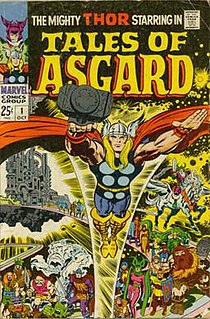
Asgard is a fictional realm and its capital city appearing in American comic books published by Marvel Comics. Based on the realm of the same name from Norse mythology, Asgard is home to the Asgardians and other beings adapted from Norse mythology. Asgard first appeared in Journey into Mystery #85 by Stan Lee, Larry Lieber and Jack Kirby, and features prominently in stories that follow the Marvel Comics superhero Thor, who appeared two issues earlier.

Balder the Brave is a fictional character appearing in American comic books published by Marvel Comics. The character is based on the deity Baldr from Norse mythology.

Odin is a fictional character appearing in American comic books published by Marvel Comics. The character is first mentioned in Journey into Mystery #85, then first appears in Journey into Mystery #86, and was adapted from the Odin of Norse mythology by Stan Lee and Jack Kirby. The character is depicted as the father of Thor and former king of Asgard.

The Executioner is the name of different fictional characters appearing in American comic books published by Marvel Comics.
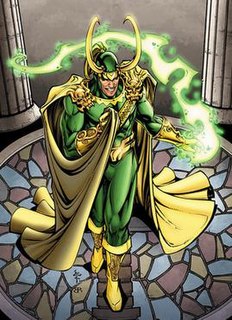
Loki is a fictional character appearing in American comic books published by Marvel Comics. Created by writer Stan Lee, scripter Larry Lieber and penciller Jack Kirby, a version of the character first appeared in Venus #6. The modern-day incarnation of Loki first appeared in Journey into Mystery #85. The character, which is based on the Norse deity of the same name, is the Asgardian "God of Mischief", the adopted son of Odin and the brother of the superhero Thor. Loki has been portrayed as both a supervillain and antihero. The character is most often strictly depicted as a male, but has on occasion been depicted as genderfluid.
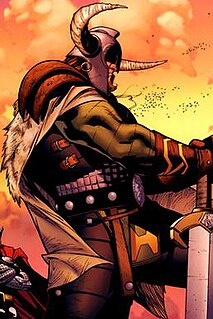
Heimdall is a fictional character appearing in American comic books published by Marvel Comics. The character is based on the Norse deity Heimdallr. Heimdall is described as all-seeing and all-hearing and is the sole protector of the Bifröst in Asgard.

The Destroyer is a fictional magical character appearing in American comic books published by Marvel Comics. Usually depicted as an opponent of the Thunder God and hero Thor, it is in fact a suit of Asgardian armor animated by magic. The character first appears in Journey into Mystery #118 and was created by Stan Lee and Jack Kirby.
The Norse mythology, preserved in such ancient Icelandic texts as the Poetic Edda, the Prose Edda, and other lays and sagas, was little known outside Scandinavia until the 19th century. With the widespread publication of Norse myths and legends at this time, references to the Norse gods and heroes spread into European literary culture, especially in Scandinavia, Germany, and Britain. In the later 20th century, references to Norse mythology became common in science fiction and fantasy literature, role-playing games, and eventually other cultural products such as Japanese animation.

Volstagg is a fictional character appearing in American comic books published by Marvel Comics. He is a charter member of the Warriors Three, a trio of Asgardian adventurers and supporting cast of Thor. He is known for having multiple children. These include, but are not limited to, Hilde, Rolfe, and the adopted Midgardians Kevin and Mick.

Sif is a fictional character appearing in American comic books published by Marvel Comics. The character is depicted commonly in association with the superhero Thor. Based on the Norse goddess Sif, she was created by Stan Lee and Jack Kirby and first appeared in Journey Into Mystery #102. As an Asgardian warrior and lover of Thor, Sif often accompanies Thor into battle. She has also battled alongside Balder, who has developed an unrequited attraction to her, as she never shows affection for anyone but Thor and certain individuals who have proved worthy to wield his hammer, Mjolnir, such as the noble alien warrior Beta Ray Bill and the mortal Eric Masterson.
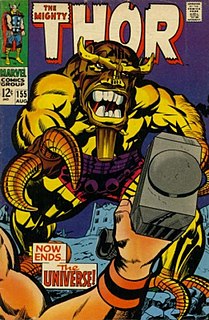
Mangog is a fictional character appearing in American comic books published by Marvel Comics.

Surtur is a fictional Fire Giant appearing in American comic books published by Marvel Comics. He usually appears as a villain in stories featuring the Norse hero Thor. Based on the fire giant Surtr from Norse mythology, and was adapted by writer Stan Lee and artist Jack Kirby, and first appeared in Journey into Mystery #97. The character was once described as one of "The Ten Most Heinous Enemies of the Mighty Thor".

Frigga is a fictional character appearing in American comic books published by Marvel Comics. The character appears in particular in those featuring the superhero Thor, who is Frigga's son. Based on both Frigg and Freyja of Norse mythology, she was created by writers Stan Lee and Robert Bernstein and artist Joe Sinnott, and first appeared in Journey into Mystery #92.
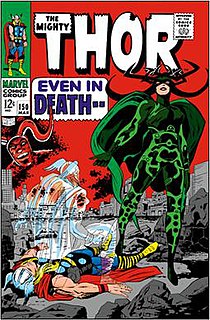
Hela is a fictional character appearing in American comic books published by Marvel Comics. The Asgardian goddess of death is based on the Norse goddess Hel. The ruler of Hel and Niflheim, the character has been a frequent foe of Thor. Debuting in the Silver Age of comic books, Hela first appeared in Journey into Mystery #102 and was adapted from Norse mythology by editor/writer Stan Lee and artist/writer Jack Kirby.

Tyr is a fictional character, an Asgardian god appearing in American comic books published by Marvel Comics. The character is based on the Norse god of the same name. Along with Thor and Balder, he is one of Odin's biological sons.

Jormungand, also known as the Midgard Serpent and the World Serpent, is a fictional character that appears in comic books published by Marvel Comics. The character, based on the serpent Jörmungandr from Norse mythology, first appears in Marvel Tales #105, in the period between the Golden Age of Comic Books and the Silver Age of Comic Books.

Lorelei is a fictional character appearing in American comic books published by Marvel Comics. She is based on the being Lorelei from Germanic mythology.

This is a page that shows the alternative versions of Thor, based on the mythological character.
Eitri the Dwarf King is a fictional character appearing in American comic books published by Marvel Comics. Eitri is a Dwarf who lives on Asgard. He is a weapons forger and is notable for being the one who created Mjolnir for the Norse God Thor. He has also occasionally aided the New Mutants.

















